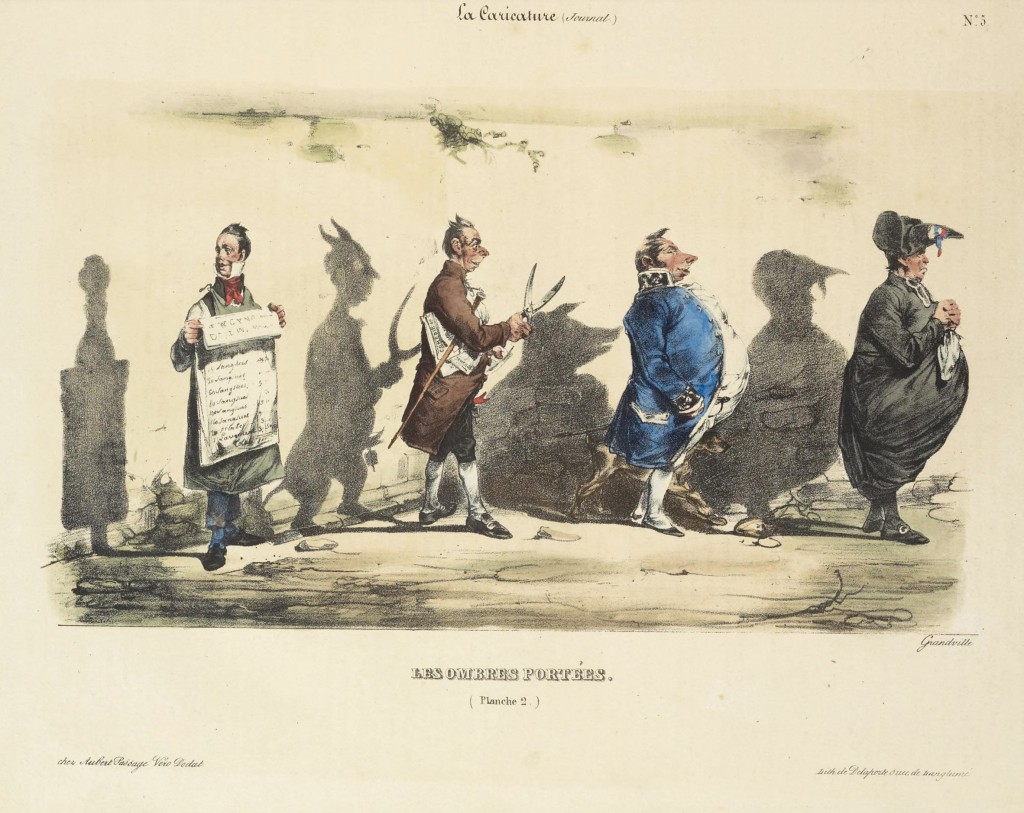Biography of J.J. Grandville (1803-1847)
DIED: March 17, 1847, Vanves
WIFE: Marguerite-Henriette Fischer (m. 1833 d. July 27, 1842) and Madame Lhuillier (m. 1843)
CHILDREN: Three children who died in infancy including Georges
J.J. Grandville was born on September 15, 1803. At the age of 12, he entered into lycée at Nancy. His formal education at lycée was short-lived, electing to be educated by his father instead. According to Les métamorphoses du jour, Grandville drew from morning to night and drew everything including objects and people.
“Du reste, il dessinait du matin au soir, il dessinait tout, personnes et choses, et il accrochait ses charges aux murailles de sa chambre, comme Téniers accrochait les siennes aux murailles de son cabaret.” Charles Blanc from Les métamorphoses du jour
He departed for Paris [in about 1823] to work in Mansion’s studio. While at the studio, he invented a game of cards with 52 cards that were published under the name of Sibylle des Salons. He then worked for Hippolyte Lecomte but he found oil painting complicated, unnecessarily difficult, and a useless to perfect. He was discourage and was ready to return to Nancy when the theater [l’Opéra-Comique] offered him the job of costume illustrator which was not lucrative but during this time he discovered lithography.
Lithography allowed Grandville to invent and to think. According to Les métamorphoses du jour, Grandville did a great deal of thinking about everything he had observed. His work included illustration for Dimanches d’un bon bourgeois and Tribulations de la petite propriété. During this time he lived in a room at l’hôtel Saint-Phar on le boulevard Poissonnière and received advice from Duval-Lecamus, son of the illustrator and M. Falampin, then a lawyer, who lived on la rue des Petits-Augustins and was active in the artistic community.
Falampin was part of the artistic community in the area and soon Grandville moved to take lodgings near his friend. The artistic community was founded by Achille Ricourt who met with other artists at five o’clock each day in salons of rue Saint-Benoît. Some of the artists included Paul Huet, Jules Janin, and Chenavard, along with 20 others. His apartment faced the palais des Beaux-Art [no. 10 rue des Petits-Augustins], contained a bed a table and six chairs. With a large green curtain, he separated his room into a bedroom area and his studio. The studio area contained the window and so his bedroom did not receive any light. If he had many guests, he would remove the curtain to create one vast room.
“Il avait, au cinquième étage, dit M. Clogenson dans une maison située en face du palais des Beaux-Arts, une mansarde spacieuse, dont son esprit inventif savait tirer un rare parti. Outre le lit, la table et les six chaises qui composaient son ameublement, ses amis se rappellent un vaste rideau vert qui servait à partager en deux son appartement. Une partie, non éclairée, était sa chambre à coucher; l’autre, ornée d’une fenêtre en tabatière, par laquelle le soleil envoyait libéralement ses rayons, constituait l’atelier. Quand les visiteurs étaient nombreux, on relevait le rideau, et le tout formait un vaste salon.” Charles Blanc from Les métamorphoses du jour
In 1827, he published ten plates for Quatre Saisons de la Vie humaine which covers the life of men from the age of 2 to 70. His then published Voyage pour l’Éternité but found his success with the following work Métamorphoses du Jour which were caricatures of contemporary human figures as they might be if they were animals. These plates generated buzz and two authors, Paul Lacroix and Ozanneaux, created a piece for the Odeon based on this title. In Les métamorphoses du jour, the author relates that Grandville found his inspiration from Buffon, studying the illustrations from a small English edition of l’Histoire naturelle: Extracts from Buffon. He followed this success with many more caricatures including his work for the journal la Caricature.
In 1833, he traveled to Nancy and married Marguerite-Henriette Fischer and returned with his wife to Paris and settled in an apartment on rue des Grands-Augustins. He had three children from the marriage and loved his private life. When he drew a representation of France, he used his wife as his model. His work during this period included Chansons de Béranger. He also published his works in le Magasin pittoresque.
In 1837, he took on the task of creating plates for les fables de La Fontaine and created many of the plates in Saint-Mandé. During this period he lost two of his children before they reached the age of 4. One of the children died in front of his parent’s eyes, chocked to death by a piece of bread at the dinner table.
On July 27, 1842, his wife died and before her death, knowing his need for a strong domestic life, made him promise to carry-on even suggesting a suitable companion. He was overcome by grief but honored his wife’s wish, returning to Nancy in 1843 to marry Madame Lhuillier.
In 1844, he moved to rue des Saints-Pères. His works during this period include Les Fleurs animées and Etoiles animées. During his work on Etoiles animées, his only remaining son, Georges, died suddenly. Grandville fell ill and, a few days before his death, he complained about a throat ache. He believed his death was near and became delirious. He was sent to Dr. Voisin’s medical facility at Vanves where he died with 48 hours on the 17th of March, 1847. He was buried in Saint-Mandé.
Other Illustrations
Un Autre Monde
Aventures de Robinson Crusoe
Voyages de Gulliver dans des contrées lointaines
Scènes de la vie privée et publique des animaux
[Summarized from Charles Blanc introduction in Les métamorphoses du jour, 1869]


